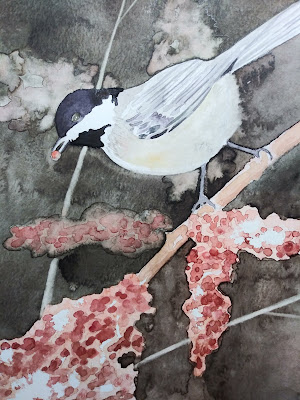I asked last summer’s workshop students to share what they’re working on now. Some are painting like mad; others are weighed down with work, elder-care or other responsibilities, but they’re all doing art. That, to me, is their greatest success.
Ann Trainor Domingue
“I’m using small collage pieces to design much larger paintings. Exploring more graphic, simpler design, with my ‘relationship’ series. I’m basically continued on my coastal-inspired work but contemplating how to include aspects of the sailing adventure. In the above watercolor-and-ink I have used a rocky coastline with evergreens as found along the coasts we sailed past on the American Eagle.
“Collage has been new for me. It is a way to simplify my designs, and I love using found small flat papers, packaging, fabric to build design I wouldn’t have using a drawing tool.”
(Note: Ann Trainor Domingue will be teaching a workshop in my studio on June 6. For more information, click here.)
Lisa Magoun
“I’ve been painting since this summer in watercolor. I also take a class painting in acrylics with a palette knife. I sometimes run out of subjects and should paint the same thing more than once. But I rarely do.”
Jennifer Johnson
“I am currently enjoying a year full of endless summer by painting in Australia. Most of my efforts have been attempted inside because the annoying bush flies are worse than ever and it is hard to paint wearing a black bug net/veil.”
Patty Mabie
I am ‘wintering’ in Florida for the first time! We are staying in Key West until the end of February, then driving across the country and back in March, to visit our kids in Birmingham and LA, with stops in New Orleans, Austin, Tucson, the Grand Canyon and who knows where else along the way. Then Myrtle beach in April, and Colorado after that to go to the Plein Air Convention and do some painting with friends in the mountains.
I bring paints everywhere and even knock one out in the car once in a while (while someone else is driving, obviously), with my Guerilla pochade box and some Gamsol in the cup holder. I’ve been doing boat studies and palm trees. I found some local art organizations and a plein air group that meets on Wednesdays here, which is great. I’m also doing an online mentoring program with Matt Smith through Tucson Art Academy Online.
Rhea Zweifler
I’ve been very interested in paths and keying up local color and the interplay of compliments together in color instead of just copying one of the Group of Seven.
Jennifer Little
Since I returned from Maine, I have had more energy for painting than I’ve had since my twenties! That week of painting really opened up something, so thank you!
Currently I am working from photos, some from Schoodic, but a theme I’m working on is related to humans and nature/the sea. I use family photos. There is something about the atmosphere in the candid shots – family dynamics, some have tension, some so serene. I am also exploring glazing geometric and hopefully dynamic skies with these organic sea scenes.
Rebecca Bense
I painted a study of sky every day in June, July and August. Then September came and I went back to my ‘real’ life, thinking I was going to keep this up for a year, but I found on day 10 of September that I was 5 days in arrears and what I had done was phoning it in. So, I stopped. Long and short: not much painting has been going on. I find myself exhausted. I decided to keep a sketch book-journal/planner and I have been doing these mandala type doodles out of ink and whatever I might have a hand. I am finding these so much fun and so little pressure to produce something. Also (not coincidentally) my drawing skills have improved.
I am teaching a drop-in watercolor class and about 80 students at a Montessori school. They range from 3 to 14 years of age. I also teach a differently-abled adults art class.
I get together with my plein air friends as much as I can. We paint outside when possible and often have at least one meal together. Nice bunch of peeps!
Sandy Waldo
The holidays are over and now winter settles in. With the business of the season painting became less of a priority. We had some snow over the weekend which inspired this view of my favorite walking trail.
Mary Ellen Pedersen
I worked on this for months in multiple versions. The boat was too big – too small – didn’t fit the right angles. I was working from a photo. Then I just said it was my painting, not the photo, and was free. I was able to be creative with it and it now hangs in my daughter’s apartment in Tennessee. I actually like my dory and the age of the vessel. I think it looks old and well used. The water and sky are a combination of dry brush with paint and paper.
Robin Miller
I have applied new learnings to an old backlog of unfinished projects with commendable results, and completed three new paintings. They were not, alas, painted outside. I probably won’t do much plein air until I can retire. But the new tools have definitely been helpful in moving through projects more quickly. And, since I tend to think of my work as a giant art project anyway, it has made that more fun as well. All in all, the Schoodic Workshop was excellent mind expansion, artistically and otherwise.










